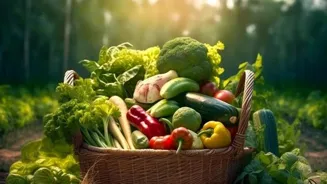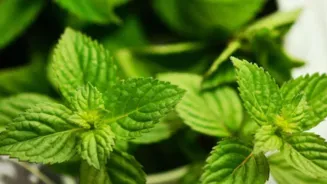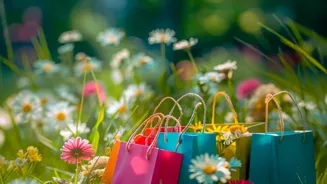Unlock the world of Organic Gardening: Grow fresh, healthy produce at home. Dive into the joy of nurturing nature, body, and planet. Read more for simple tips to start your organic garden today. Let's
cultivate together!
Namaste, readers! Are you tired of the same old vegetables and fruits from the market? Do you dream of fresh, healthy produce grown right in your own home? Well, your dream can come true!
Organic gardening isn't just a hobby; it's a way to connect with nature, nourish your body, and contribute to a healthier planet. Think of juicy tomatoes bursting with flavour, crisp cucumbers just waiting to be sliced, and fragrant herbs to spice up your chai.
It's all possible with a little bit of effort and these simple organic gardening tips! So, grab your gardening gloves, and let's get started on this exciting journey. It's easier than you think, and the rewards are oh-so-delicious!
7 Steps to Start Your Organic Garden Today!
Choose ideal garden location for sunlight, soil, water access
The first step in creating a successful organic garden is choosing the right location. Most vegetables and fruits need at least six to eight hours of sunlight per day. Observe your garden area throughout the day to see where the sun shines the longest. Also, consider the soil.
Ideally, you want well-draining soil that is rich in organic matter. If your soil is heavy clay or sandy, don’t worry! You can amend it with compost, which we will talk about later. Choose a spot that is easily accessible to a water source, such as a tap or a rain barrel.
This will make watering your plants much easier. Avoid areas near trees with large roots, as they can compete with your plants for water and nutrients. Finally, think about the size of your garden. Start small, especially if you are a beginner.
A small, well-maintained garden is better than a large, overgrown one. You can always expand later as you gain experience. Observe how the Sunlight falls and plan accordingly. Avoid area that are near electrical cables and pipes. Always ensure that the area is safe to work.
Healthy soil is key to an organic garden: prep, test pH, add compost for nutrients
Healthy soil is the foundation of a healthy organic garden. Before planting, prepare your garden bed by removing any weeds, rocks, and debris. Then, test your soil's pH level. You can purchase a simple soil testing kit at most garden centres.
Most vegetables prefer a slightly acidic to neutral pH of around 6.0 to 7.0. If your soil is too acidic, you can add lime to raise the pH. If it's too alkaline, you can add sulfur to lower the pH. But the most important thing you can do is to add lots of organic matter! Compost is your best friend.
Compost is decomposed organic material, such as leaves, grass clippings, and kitchen scraps. It improves soil drainage, provides nutrients, and helps retain moisture. Dig compost into your garden bed to a depth of several inches.
You can also add other organic amendments, such as aged manure or bone meal, to further enrich the soil. Raised beds are a good option if you have poor soil or limited space. Fill them with a mixture of high-quality compost, topsoil, and other organic amendments.
Start seeds indoors or buy seedlings for planting success
You have two main options for getting your plants started: starting seeds indoors or buying seedlings from a nursery. Starting seeds indoors allows you to get a head start on the growing season, especially for plants that need a long time to mature, such as tomatoes and peppers.
Use seed-starting trays and a good quality seed-starting mix. Keep the soil moist and provide plenty of light. Once the seedlings have developed a few true leaves, you can transplant them into larger pots or directly into your garden bed.
Buying seedlings from a nursery is a convenient option, especially if you are a beginner. Choose healthy-looking seedlings with strong stems and no signs of disease or pests.
Before planting, harden off the seedlings by gradually exposing them to outdoor conditions for a few hours each day for a week or so. This will help them adjust to the sun and wind and reduce transplant shock. Remember to handle the delicate roots with care when transplanting.
Provide ample water post planting your seeds. Label your garden beds and create a plan of what you want and where you want it to be.
Proper watering techniques for plant health and growth
Water is essential for plant growth, but overwatering can be just as harmful as underwatering. Water deeply and less frequently, rather than shallowly and often. This encourages roots to grow deep into the soil, making plants more drought-tolerant.
Water in the morning to allow the foliage to dry before nightfall, which can help prevent fungal diseases. Use a watering can or a hose with a gentle spray nozzle to avoid damaging delicate plants. Consider using a soaker hose or a drip irrigation system to deliver water directly to the roots.
This is especially helpful in hot, dry climates. Mulching around your plants with organic materials, such as straw or wood chips, can help retain moisture in the soil and reduce the need for watering. Observe your plants carefully for signs of stress, such as wilting leaves or yellowing foliage.
Adjust your watering schedule accordingly. And don't forget to collect rainwater! It's a sustainable way to provide your plants with a natural source of water.
Organic gardening principles: natural methods, companion planting, pest control tips
One of the main principles of organic gardening is to avoid synthetic pesticides and herbicides. Instead, use natural methods to control pests and diseases. Companion planting is a great way to deter pests and attract beneficial insects.
For example, planting marigolds near tomatoes can help repel nematodes. Other beneficial insects, such as ladybugs and lacewings, prey on common garden pests like aphids and caterpillars. Attract them to your garden by planting flowers that provide nectar and pollen.
Handpicking pests is a simple and effective way to control small infestations. Regularly inspect your plants for signs of pests or diseases. If you spot a problem, take action immediately. Insecticidal soap and neem oil are natural pesticides that can be used to control a wide range of pests.
Apply them according to the instructions on the label. Crop rotation is another important practice for preventing pests and diseases from building up in the soil. Rotate your crops each year so that plants from the same family are not planted in the same location year after year.
With commitment you can keep your garden flourishing and safe from pests and insects.
Regular weeding vital for healthy garden; do it after rain with proper tools
Weeds compete with your plants for water, nutrients, and sunlight. Regular weeding is essential to keep your garden healthy and productive. The best time to weed is after a rain when the soil is moist and the weeds are easier to pull out.
Use a weeding tool to loosen the soil around the weeds and pull them out by the roots. Avoid breaking off the weeds at the surface, as they will likely grow back. Mulching around your plants can help suppress weed growth.
Apply a thick layer of organic mulch, such as straw, wood chips, or shredded leaves. A vegetable garden should be a source of joy and relaxation. Make weeding more manageable by doing it regularly. It's far easier to pull a few weeds each day or week than to deal with a garden full of overgrowths.
Be methodical, moving row by row or section by section to do complete job. Adding this to a regular garden schedule takes the chore element out of it.
Harvest fresh produce at peak ripeness, store properly, share joy
The most rewarding part of organic gardening is harvesting your own fresh, delicious produce. Harvest vegetables and fruits when they are at their peak ripeness. This is usually when they are fully coloured, firm to the touch, and have a pleasant aroma.
Harvest herbs regularly to encourage new growth. Cut them back by one-third to one-half. Store your harvest properly to keep it fresh for as long as possible. Some vegetables and fruits, such as tomatoes and peppers, should be stored at room temperature.
Others, such as leafy greens and root vegetables, should be stored in the refrigerator. Share your harvest with friends and neighbours! Gardening is a rewarding experience that can bring you closer to nature and your community. Pat yourself as you consume the tasty vegetables with satisfaction.
AI Generated Content. Glance/InMobi shall have no liability for the content










